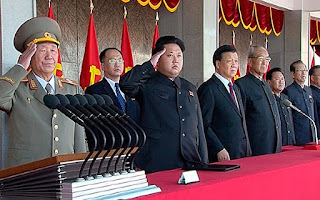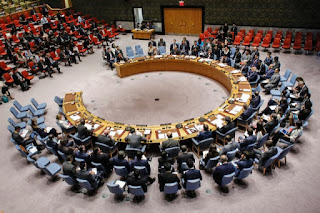Russia’s ‘Zapad 2017’ Military Exercise Stokes Anxiety amongst NATO Countries
Russia’s
‘Zapad 2017’ Military Exercise Stokes Anxiety amongst NATO Countries
By E. Stanley Ukeni @EzStan
In what has been touted in the
western media as one of the most elaborate demonstrations of military might by former
Warsaw Pact allies since the Soviet era, Russia and Belarus have commenced
joint military maneuvers near their shared border with NATO member countries.
(RIA-Novosti, Mikhail Klimentyev)
According to the Russian Ministry
of Defense website, the Zapad 2017 war games will involve approximately 5,500
Russian troops, 7,200 troops from Belarus, up to 70 aircrafts, 250 tanks, 200
artillery pieces and 10 navy ships. However, some have disputed these numbers,
claiming that the Russians grossly understated the number of troops and military
personals that would be participating in the exercise by tens of thousands.
Several military and
intelligence analysts have argued that the Russians deliberately rounded up the
number of troops that will be participating in the war games to 12,700 in other to avoid its obligation, as a member
of the Organization for Security and Cooperation in Europe, to invite observers
from the other member countries whenever more than 13,000 troops are involved
in its military maneuvers.
As the war games begins along
its western border today, there is a marked rise in anxiety within the
countries bordering the west of the Russian Federation, and within the
corridors of the NATO headquarters—especially so, due to Russia’s current
contentious relationship with its NATO neighbors such as Poland and Romania.
The Zapad 2017 military exercise
is a massive military drill that the Russian military conducts every four
years, along with its strategic ally Belarus, to simulate defensive and counter
offensive strategies in the event of a war with NATO member countries. The fact
that particular drill will include activities on the borders of Poland and
Lithuania has heightened concerns amongst Western countries.
The Zapad, which literally
means west, is an intense military drill that has been ongoing since 1999. This
year’s edition is scheduled to run from the 14th through the 20th
of September. And as the name connotes, it is designed to ensure Russian
military readiness ward off an invasion from the west of its borders.
Vadim Savitsky | TASS | Getty Images
T-72B1 battle tanks take part in military exercises near Murom as part
of an operational meeting of the Russian Armed Forces top officials.
The reason for the increased
nervousness amongst NATO countries is probably because of the growing mistrust
between the United States and Russia. Truth be told, there is merit to the
growing concern among Eastern European countries—and perhaps the United States,
for the military resurgence of a Russia State that is hell-bent on advancing
its global interest—with force of arms where necessary.
Since the last large scale
Russian military drill in 2013, the country’s growing military
assertiveness—brought on by its annexation of Crimea and a believe that it has
a hand in fomenting instability in eastern Ukraine, and equally its robust
military involvement in the Syrian civil conflict, is causing the United States
and other NATO countries to reevaluate Russia’s commitment to global peace and
security.
In light of this recent history
of Russia’s increasing willingness to use force to advance its strategic
interests, the Baltic member countries of NATO are particularly worried that
the Russian military may use the guise of the exercise to make unsanctioned
incursions into their territorial waters and airspace. Although the Russian
have tried to dismiss such fears as unwarranted, the leaders of the three
Baltic States are nevertheless keeping a wary eye on the military exercise as
it unfolds.
Perhaps the Western uneasiness
is born of the fact that, in recent year, an increasingly politically assertive
and militarily emboldened Russia has begun to systematically challenge
America’s global preeminence. There are those who believe that the mid to long
term goal of the Russian leadership is to re-enthrone a multipolar world order,
where Russia would serve as a counter-weight to an American dominated world
order.
In the lead up the commencement
of Zapad 2017, many western military and security experts and intelligence
analysts have warned that Kremlin might use the exercise to beef up Russian the
strategic military bases in Belarus and its satellite region of Kaliningrad—not
far from its western borders.
Some of these experts have even
gone as far as suggesting that Moscow may use the guise of the exercise to
funnel sophisticated military hardware to Russian-backed separatist fighters in
eastern Ukraine.
Speaking on the Russian
military maneuver, in a speech made in the Baltic State of Estonia on September
6th, the NATO Secretary General, Jens Stoltenberg, said, “Briefings
on the exercise scenario and progress; opportunities to talk to individual
soldiers; and over-flights over the exercise. This is something that is part of
the Vienna document, an agreement regulating transparency and predictability relating
to military exercise.”
Although the Russians have
invited NATO observers to monitor the exercise, in accordance with its
international obligation, Brussels has however raised concern that Russia’s
offer to allow three experts to attend some of the military exercises is not in
conformity with the spirit of its international obligations under the Vienna
convention.
The Russian Ministry of Defense
has states on its website that the Zapad 2017 anti-terror exercise is a
defensive maneuver. The site explains the scenario being used for the war games
as this, “…The exercise stipulates that some extremist groups have penetrated
to the territories of the Republic of Belarus and the Kaliningrad region of the
Russian Federation in order to carry out terrorist attacks and destabilize the
United State of Russia and Belarus.”
Arrayed against the
Russian-Belarus alliance, in the six-day war games, are fictitious aggressor
countries called Veishnoriya, Lubeniya and Vesbasriya. Some have insinuated these
names are veiled disguises for the Baltic States of Latvia, Lithuania and
Poland, but there is no way to know that for sure.
Mindful of Russia’s discontent
with NATO’s eastwards expansion, Brussels has already taken a number of
measures to dissuade any Russian aggression against the Treaty Organization’s
eastern members. This includes the deployment of approximately 30,000 NATO
troops in Poland. Over the years, the actions of the North Atlantic Treaty Organization (NATO) have communicated to Russia NATO’s determination to defend
its member countries in the event of aggression.
Authored by E. Stanley Ukeni, ©
2017. All Rights Reserved. This material and other articles or stories posted
on this blog site may not be reproduced, published, broadcast, rewritten or
redistributed, in whole or in part, without prior expressed written permission
from the author, E. Stanley Ukeni.
You are invited to follow E.
Stanley Ukeni on twitter at; @EzStan . You’re equally invited to follow him on
google+. Oh yeah, don’t forget to subscribe to this blog Site. Thanks.
Photo
Credits:









This comment has been removed by a blog administrator.
ReplyDelete